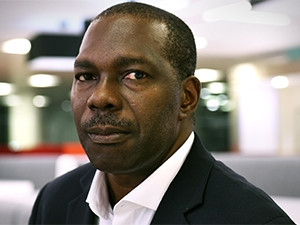
The GSM Association, the organisation that represents the interests of mobile operators worldwide, has thrown its weight behind calls by local mobile operators for more spectrum allocation in SA.
Speaking at the 2016 Internetix Technology Conference yesterday, Mortimer Hope, director for Africa at the GSMA, said the mobile network is available but mobile broadband is not.
Hope made the comments in response to a debate about ensuring the connectivity of all South African citizens by 2020.
We can use whatever technology is available, which is suitable to the conditions to get people connected, so where WiFi is available, use it by all means; but we need to ensure we have mobile broadband covering the country and to do that we need to get additional spectrum, Hope stated.
"There is a shortage of spectrum right now and we need to address that." There are other frequency bands like the digital dividend that must be considered and need to be allocated, Hope noted.
Spectrum sweet spot
SA's mobile operators have been calling for additional spectrum for years, but there has been little movement towards auctioning the spectrum.
MTN SA CEO Mteto Nyati previously said in order to provide quality network and mobile broadband services to customers, the Independent Communications Authority of SA (ICASA) needs to allocate high-demand spectrum.
According to Dobek Pater, MD of Africa Analysis, there is a range of spectrum that can be released but the larger operators like MTN and Vodacom would prefer spectrum in the range of 2 600MHz, 800MHz and 700MHz.
3.5GHz is another spectrum block that could be released and would be suitable for a number of smaller players, says Pater.
The allocation of spectrum will allow the deployment of 4G/LTE infrastructure and services to far greater extent than we have seen to date, and will result in better quality signal, he says.
Pater explains: "The low-frequency spectrum (800MHz + 700MHz) can be used to connect peripheral areas most cost-effectively with mobile broadband... The strategy normally is to use 800MHz spectrum as it has wider coverage off a mobile cell, but switches users seamlessly to higher frequency (eg, 2 600MHz) in congested areas to retain good signal quality."
Ovum analyst Richard Hurst notes the release and appropriate allocation of spectrum will unlock SA's mobile broadband market.
"Network operators will be able to provide greater coverage, greater throughput speeds at a lower cost. The knock-on effect will be greater uptake of broadband services among South African consumers and the development of new content, services and applications for use across these networks."
Party politics
ICASA, which has been tasked with the process of allocating in-demand spectrum, has been in a tussle with the Department of Telecommunications and Postal Services (DTPS) on how valuable spectrum will be assigned.
Member of Parliament Cameron MacKenzie explained that in a recent telecommunication and postal services portfolio committee meeting, ICASA and the DTPS presented opposing opinions on the issue.

DTPS minister Siyabonga Cwele and the department's acting DG Joe Mjwara have little liking for the globally favoured spectrum auction process, while ICASA appears to strongly favour the spectrum auction method, noted MacKenzie.
"It is common cause that the release of spectrum in the 700MHz, 800MHz and 2.6GHz range is a major bottleneck in delivering more high-speed bandwidth to South Africans thirsty for access to ubiquitous broadband," he said.
The red tape surrounding the allocation of in-demand spectrum is a combination of inadequate capacity and politics between ICASA and the state departments - DTPS and the Department of Communications (DOC), notes Pater.
"Initially, ICASA had capacity constraints. Thereafter, we have been waiting for the DOC to move the TV/radio signal broadcasters out of the low frequency spectrum and make it available to the operators.
"On the DTPS side, ICASA has been waiting for the department to release a policy directive on the issue of spectrum, including the format in which the spectrum should be awarded - a beauty contest, an auction or a combination of both. The policy directive should be released by end-March 2016. All in all, the process is running some two to three years behind schedule," states Pater.
Hurst notes there have been splits with the various government departments and the development of a broadband policy, which have placed the entire process on hold. "I think government has become bogged down in its bureaucracy and the notion of doing it right."
Digital dividend
George Kalebaila, senior research manager for telecoms and media in Africa at the IDC, says SA's digital migration process needs to be completed so that mobile operators can access the prime spectrum they are calling for.
The in-demand spectrum is currently occupied by analogue TV, according to Kalebaila.
South Africa missed the International Telecommunication Union's June 2015 deadline to migrate all analogue signals to digital terrestrial television. Although the country's digital migration process has since begun, it is running behind schedule.
"Migration to digital TV is of prime importance because it will free up this spectrum for 4G/LTE use. Most of the current LTE deployments are either in GSM or 3G bands, and telcos had to re-farm these frequencies to make space for LTE. This is not ideal for mass deployment as it takes away capacity from 2G/3G services that are equally important," he says.
Kalebaila adds: "This spectrum is important because it has longer range, allowing telcos to cover large areas with fewer LTE base stations. This is cost-effective as it reduces the capital outlay by telcos and should also help telcos provide affordable 4G services to consumers and business alike."
It is therefore imperative government's digital migration process is accelerated because the longer it takes, the more it delays the mass deployment of better mobile broadband services, he notes.
"Whatever impediments to faster migration to digital TV can't overshadow the critical importance of releasing this spectrum because it is impeding growth and deployment of advanced digital services."
Hope noted: "We need to ensure we complete digital migration and license that spectrum as quickly as possible."
Share